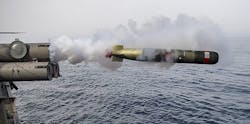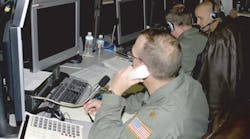The Mark 54 torpedo is a lightweight anti-submarine weapon fired from helicopters, fixed-wing aircraft, and from surface vessels. Raytheon is the original Mark 54 designer, and the torpedo combines the homing and warhead subsystems of the Mark 50 torpedo with the propulsion unit of the older Mark 46 light torpedo.
The Mark 54 has better performance than the Mark 46 in shallow-water anti-submarine warfare (ASW), and reduces the costs of the Mark 50 torpedo with commercial off-the-shelf (COTS) components. Navy submarines use advanced versions of the larger Mark 48 heavy torpedo.
Raytheon will produce Mark 54 Mod 0 lightweight torpedo kits, and provide related engineering and repair services to repair and upgrade the Navy's lightweight torpedoes that are staples of the Navy MH-60 Sea Hawk helicopters, and will be fitted to the Navy's new P-8 Poseidon maritime patrol jet.
Related: Boeing to make flying torpedoes able to attack enemy submarines from 30,000 feet
The Mk 54 can be fired from surface ships via the Mark 32 surface vessel torpedo tubes or the vertical launch anti-submarine rocket (ASROC) systems, and also from most ASW aircraft, although they are slightly different lengths and weights.
Engineers at the Boeing Co. Defense, Space & Security segment in St. Charles, Mo., are building an add-on kit for the Mark 54 that will enable the torpedo to glide through the air from altitudes as high as 30,000 feet and enable the P-8A Poseidon jet to attack enemy submarines from long ranges.
The Boeing High Altitude Anti-Submarine Warfare Weapon Capability (HAAWC) Air Launch Accessory (ALA) turns the Raytheon Mark 54 torpedo into a glide weapon for the P-8A. As the flying torpedo reaches the water, it jettisons wings and other air-control surfaces and takes on its original role as a smart torpedo that detect, track, and attack enemy submarines autonomously.
The torpedo kits that Raytheon is producing in the latest contract will include the torpedo's processor group assembly (PGA), control group assembly (CGA), inertial measurement unit (IMU), cables, fuel tank, and afterbody upgrade items such as dual winding alternator (DWA), speed control value (SCV), bulkhead, and other parts.
The contract calls for Raytheon to produce Mark 54 MOD 0 torpedo kits for the U.S. Navy, as well as for the militaries of India, Turkey, and Australia. Raytheon will do the work in Keyport, Wash. and Portsmouth, R.I., and should be finished by early 2018.
For more information contact Raytheon Integrated Defense Systems online at www.raytheon.com, or Naval Sea Systems Command at www.navsea.navy.mil.



